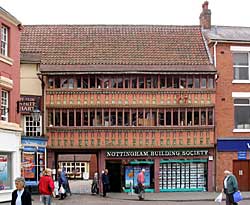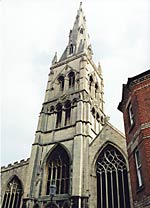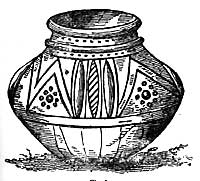
Structual
 The 15th century front range
of The Old White Inn in the market place.
The 15th century front range
of The Old White Inn in the market place.Standing buildings
Despite redevelopment in the second half of the 20th century, Newark still possesses a great number of buildings of architectural and historic interest. The Georgian period is particularly well represented and there are a small number of medieval buildings of note. In 1964 the Council for British Archaeology included Newark in its list of 51 British towns of outstanding historic quality.
The town is dominated by one of the finest parish churches in the country and the castle with its distinctive Norman gateway commands the river crossing (an arm of the River Trent). A comprehensive, illustrated survey of the historic buildings of Newark was published in the late 1960s:
- Nottinghamshire County Council: Planning and Transportation Department, Newark: Action for Conservation, West Bridgford: Nottinghamshire County Council, 1968
An informed overview of the town’s architecture is available in the latest edition of Pevsner’s Nottinghamshire:
- Nikolaus Pevsner (revised by Elizabeth Williamson), The Buildings of England: Nottinghamshire, Harmondsworth: Penguin Books, Second Edition: 1979, pp180-200
A useful introduction to the historic buildings of Millgate:
- David Marcombe and Ann Borrill, Newark’s Riverside Heritage. Millgate: a guided walk, Nottingham: University of Nottingham, Continuing Education Press, 1997
General guides to the buildings of Newark:
- Nottinghamshire County Council/Newark District Council, Newark Trail, [not dated]
- Samuels, J. R. Discover Newark. Newark: Newark Town Council, 1989
 The early 13th century tower of St Mary Magdalene
church dominates the town.
The early 13th century tower of St Mary Magdalene
church dominates the town.The magnificent parish church of St Mary Magdalene is the third church on the site. Nothing survives of the Saxon structure and only four large piers at the Crossing remain of the second church of c.1180. The impressive west tower dates from c.1230 and the rest of the church was rebuilt over the 14th and 15th centuries. A thorough and richly illustrated history of the church is
- Barbara Pask, Newark parish church of St Mary Magdalene, Newark: District Church Council of St Mary Magdalene, Newark, 2000
See also Ms Pask’s colourful booklet and her entry on the Southwell DAC Church History website:
- Brenda M Pask, The parish church of St Mary Magdalene, Newark-on-Trent, Nottinghamshire, Newark: District Church Council of St Mary Magdalene, Newark, 1995
- southwellchurches.nottingham.ac.uk/newark-st-mary/hintro.php
In the south east corner of the market place stands the White Hart Inn, which has been superbly restored by the Nottingham Building Society. The main front dates from the late 15th century; a crown post roof of the south range, however, is much earlier and has been dated to c.1350. A full documentary history and architectural/archaeological survey of the building has been published:
- John Samuels, F W B Charles, A Henstock and Philip Siddall, ‘A Very Old and Crasey Howse’: the Old White Hart Inn, Newark, Nottinghamshire, Transactions of the Thoroton Society, 100, 1996
Newark has a number of fine medieval timber-framed buildings, the best of which (the mid-15th century Woolpack Inn on Stodman Street, the early 14th century building at 22-24 Kirkgate, and The Governor’s House on Lombard Street) are discussed and illustrated in
- Jason Mordan, Timber-frame buildings of Nottinghamshire, West Bridgford: Nottinghamshire County Council, 2005
Also:
- D. L. Roberts, A Crown Post Roof in Kirkgate, Newark-on-Trent, Transactions of the Thoroton Society, 75 (1971), [discusses 37-37 Kirkgate]
The Friary was occupied by friars from 1499 to 1539. Limited excavation has uncovered the remains of buildings and burials but little is known about the layout or scale of the establishment.
- Peter Stephens, Grey Sanctuary. The story of the Newark Friary, West Bridgford: Nottinghamshire County Council, 1996
The late medieval Beaumond Cross was moved from its original position at the south end of Carter Gate to London Road Gardens in the 1970s.
- William Stevenson, The Beaumond Cross, Newark and its date, Transactions of the Thoroton Society, 1919
Other notable buildings are the fine Town Hall (built 1774-6) by Carr of York, the early 18th century Saracen’s Head and Clinton Arms, the 1960s replica of the Moot Hall (originally dating from 1708), the original Grammar School building (1532) on Appleton Gate, the early 18th century Old King’s Arms on Kirk Gate, the early 16th century Queen’s Head in the market square, the early 18th century 11 Castle Gate (recently converted to a shop from a garage), and the impressive Ossington Coffee Palace at Beast Market dating from 1882.
- I. Hall, Newark Town Hall, Georgian Group Journal, 1991
- M. Freeman-Attwood, Newark Town Hall, Nottinghamshire Observer, 26, 208,1973
 Warwick and Richardson's brewery on Northgate is
shown here in a semi-derelict state in 2005. It has since been converted to residential use.
Warwick and Richardson's brewery on Northgate is
shown here in a semi-derelict state in 2005. It has since been converted to residential use.Newark also has a fine collection of industrial buildings: Castle Brewery (1882) on Albert Street, Warwicks & Richardson’s brewery on Northgate, the office block and clock tower from W N Nicholson’s Trent Iron Works (1854), the Trent Navigational Canal warehouse (1870), and the Castle Railway Station (1846). A comprehensive survey of the industrial buildings and industrial archaeology of Newark is:
- Sheppard, R. and others. Newark's Industrial Archaeological Resource. A Report for: Newark & Sherwood District Council. Nottingham, Trent & Peak Archaeological Trust, 1993.
English Heritage's Images of England website, which aims to create a 'point in time' photographic record of England's listed buildings, holds a large number of descriptions and photographs of listed buildings in Newark:
Ruins and earthworks
 The castle with its 12th century gatehouse.
The castle with its 12th century gatehouse.It is probable that the first castle was constructed in the wake of William the Conqueror’s advance into the north in the winter of 1068-9 and was probably a motte and bailey castle. Alexander the Magnificent, Bishop of Lincoln, rebuilt and remodelled it in the 1130s-40s: the chronicler Henry of Huntingdon was moved to describe it as “a magnificent castle of very ornate construction”. Only two sections survive of Alexander’s castle: the gatehouse with short stretches of adjoining wall and the tower in the south-west corner. The castle was again remodelled c.1300 when the west curtain wall was demolished and rebuilt in the latest style on a different alignment. This allowed the building a new range of accommodation against the rebuilt wall.
The castle saw minor modifications in the 15th and 16th centuries to improve the levels of comfort (fireplaces, window glass to become “a comfortable country house” which offered hospitality to Stuart monarchs.) and played a vital role in the English Civil War. The gatehouse and curtain wall (between gatehouse and south-west turret) are all that survived the slighting of the castle after the last siege of the town in 1646.
The most recent review of the history of the castle and the results of excavations during the 1990s is:
- J R Samuels and P Marshall, The guardian of the Trent. The story of Newark Castle, Newark: Newark Castle Trust et al, 1997
Also:
- Braun, H. Notes on Newark Castle, Transactions of the Thoroton Society, 39, 1935
- Pamela Marshall, The Twelfth-century castle at Newark, in J S Alexander (ed.) Southwell and Nottinghamshire. Medieval art, architecture and industry, The British Archaeological Association Conference Transactions XXI, 1998, pp110-125
Various excavations on the site:
- Barley, M. W. and Waters, F., Newark Castle - Excavations, 1953-6, Transactions of the Thoroton Society, 60, 1956
- Coupland, F. and others, Newark Castle Studies: Excavations, 1994. [Newark Castle Trust, c.1995]
- Courtney, T. S., Newark Castle Excavation, 1972, Transactions of the Thoroton Society, 77 1973
- Dixon, P. and others, Newark Castle Studies: Excavations, 1992-1993, Newark: Newark Castle Trust, 1994
- Marshall, P. and Samuels, J. R., Recent Excavations at Newark Castle, Nottinghamshire, Transactions of the Thoroton Society, 98, 1994
- Perks, J. C., Newark Castle and the Great Tower, Transactions of the Thoroton Society, 43 1939
Newark has some of the most impressive English Civil War fortifications in the country. The Queens Sconce to the south of the town centre is extremely well preserved. It has a diamond bastion at each corner and the breastwork and ramps for the drawing up of artillery survive almost complete. For a thorough discussion of the sieges of Newark and a detailed survey of the surviving earthworks see:
- Royal Commission of Historic Monuments (England), Newark-on-Trent, the Civil War siegeworks, London: HMSO, 1964
Articles on various excavations of the siegeworks around Newark:
- W. H. Manning, Excavations at Colonel Greye's Sconce, near Newark, in July 1958, Transactions of the Thoroton Society, 62 (1958)
- M. J. Dean, Civil War Siege Defences, Millgate, Newark, Transactions of the Thoroton Society, 72 (1968), [68]-70
- C. Drage, An Excavation of the Royalist Town Ditch at Victoria Street, Newark, Nottinghamshire, 1986, Transactions of the Thoroton Society, 91 (1987), [127]-132
- A. G. Kinsley, Excavation on the Supposed Site of Civil War Redoubt 11B, Newark-on-Trent, Nottinghamshire, Transactions of the Thoroton Society, 92 (1988), [78].
- V Holyoak, Civil war monuments project, Newark-on-Trent, Nottinghamshire: rediscovery of civil war redoubt ‘z’, Transactions of the Thoroton Society, 101, (1997)
- Richard Cuttler and Eleanor Ramsey, The Excavation of Roman, Medieval and Civil War Remains at Trent Lane, Newark, Nottinghamshire, Transactions of the Thoroton Society, 109 (2005)
- Gavin Kinsley, Archaeological fieldwork on the Civil War Line of Circumvallation at Newark by Gavin Kinsley, Transactions of the Thoroton Society, 111 (2007)
Recent work at The Scottish Camp (to the west of the town), General Poyntz’s headquarters (near the Queen’s Sconce) and Shelford Manor has been summarised in:
- Tony Pollard and Neil Oliver, Two men in a trench. Battlefield archaeology – the key to unlocking the past, London: Michael Joseph, 2002, pp184-239
The King’s Sconce, lying between the River Trent and Northgate was recently uncovered and partially excavated during the construction of a supermarket:
- The King’s Sconce uncovered, Nottinghamshire Heritage News, Issue 16, Autumn 2003
Archaeology
An excellent overview of the town’s pre-industrial archaeology is
- A. G. Kinsley, Newark's Archaeological Resource: A Report for Newark and Sherwood District Council. Nottingham: Trent & Peak Archaeological Trust, 1989.
A companion publication covering Newark’s industrial archaeology:
- R. Sheppard, and others, Newark's Industrial Archaeological Resource. A Report for: Newark & Sherwood District Council. Nottingham: Trent & Peak Archaeological Trust, 1993.
The Fosse Way, connecting Exeter and Lincoln, runs through Newark and was one of the principal highways of Roman Britain. A considerable amount of Roman material has been found in the town but only small-scale excavations in the North Gate area of the town have uncovered Roman structural remains, suggesting a Roman settlement.
 Anglo-Saxon cremation urn discovered in the 18th
century.
Anglo-Saxon cremation urn discovered in the 18th
century.A pagan Anglo-Saxon cemetery situated alongside Mill Gate (the Roman Fosse Way) was excavated in the 1960s and 70s. Over 400 burials, spanning the 5th to 6th centuries, were examined: each cremated burial had been placed with offerings in an urn. A full excavation report has been published:
- G Kinsley, The Anglo-Saxon cemetery at Millgate, Newark, Nottinghamshire. Excavations between 1958 and 1978. (Nottingham Archaeological Monographs, 2) Nottingham: The University of Nottingham, 1989
Work by Trent & Peak Archaeological Trust in the 1980s at Slaughter House Lane revealed a substantial rampart dating probably to the 10th or 11th centuries.
- G Kinsley, Excavations on the Saxo-Norman town defences at Slaughter House Lane, Newark-on-Trent, Nottinghamshire, Transactions of the Thoroton Society, 97, 1993
The medieval town defences are known from documentary sources and several archaeological excavations:
- M. W. Barley, Excavation of the Borough Ditch, Slaughterhouse Lane, Newark, 1961, Transactions of the Thoroton Society, 65, 1961
- R. F. B. Hodgkinson, The Town Walls of Newark, Transactions of the Thoroton Society, 26 1922
- M. Todd, Excavations on the Medieval Defences of Newark, 1972, Transactions of the Thoroton Society, 78, 1974
- M. Todd, Excavations on the Medieval Defences of Newark, 1976, Transactions of the Thoroton Society, 81, 1977
St Leonard’s Hospital, founded in the early 13th century, lies on the north side of North Gate at the south end of the Lincoln Road viaduct. Salvage excavations in 1928 and 1979 found 170 burials and the remains of a stone building but the site is still poorly understood.
- R. F. B Hodgkinson, St Leonard's Hospital, Newark, Transactions of the Thoroton Society, 24, 1920
- M. W. Bishop, Burials From the Cemetery of the Hospital of St. Leonard, Newark, Nottinghamshire, Transactions of the Thoroton Society, 87, 1983